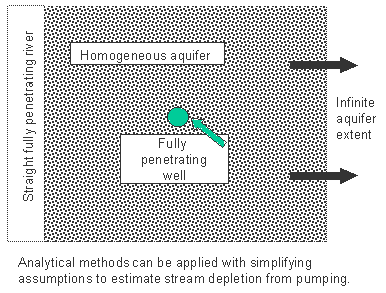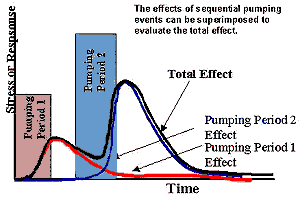Response Functions
- How are Response Functions Determined?
Response functions may be
determined by several methods. The methods may be divided into three basic
categories: 1) direct measurement, 2) analytical methods, and 3) numerical methods.
These methods vary in the level of assumtions employed and accuracy of the results.
The method selected should be commensurate with the purpose of the evaluation
and the information available for each situation. Each method is described in
the following paragraphs.
Direct measurement of stream
or spring depletion by pumping is possible in relatively few cases. Measurement
of depletion resulting from pumping of a specific well is possible only when
the well is relatively close to the stream or spring and well pumping is a significant
proportion of the stream or spring flow. It is also sometimes difficult
to isolate the effects of a single well from other influences that may be causing
changes in discharge. When it is possible to measure the relationships
between pumping and stream or spring discharge, the proportion of depletion
can be determined from measurements of stream or spring flow and well discharge.
The depletion changes with time, so observations are required at different times.
The response function can be represented by the proportion of well pumping appearing
as depletion of the stream or spring. The response function will be valid
within some limits of pumping rate, stream flow, and aquifer water level.
These limits are site-specific and related to the assumptions identified in
the section "Assumptions Supporting Response
Functions".
 Analytical methods have been developed and used to estimate the effects of ground
water pumping on stream depletion. Methods such as those of Jenkins (1968)
and Glover (1968) are burdened with intensive assumptions such as straight and
fully penetrating streams, fully penetrating wells, and homogeneous and infinite
aquifers. These methods, however, can be employed to develop response
functions when data are inadequate to use more sophisticated techniques.
In these cases, response functions involve little more than plugging the site-specific
data into explicit equations.
Analytical methods have been developed and used to estimate the effects of ground
water pumping on stream depletion. Methods such as those of Jenkins (1968)
and Glover (1968) are burdened with intensive assumptions such as straight and
fully penetrating streams, fully penetrating wells, and homogeneous and infinite
aquifers. These methods, however, can be employed to develop response
functions when data are inadequate to use more sophisticated techniques.
In these cases, response functions involve little more than plugging the site-specific
data into explicit equations.
Response functions can
be developed from numerical models in situations where more data are available
and numerical models have been developed. Some model codes generate response
functions directly, in other situations it may be necessary to run multiple
simulations, each simulating response to ground water pumping at a specific
location (model
grid with well). MODFLOW is the most widely used code for ground water
modeling. It is accepted as the industry standard for numerical modeling
of ground water systems. A detailed description of the use of MODFLOW
for developing response functions can be found in the technical article Use
of MODFLOW for Development of Response Functions. Simulated changes,
when divided by the magnitude of the pumping rate, yield response functions.
The simulations must be based on linear equations. This means that changes
in aquifer thickness from pumping must be small relative to total thickness,
and head-dependent boundary conditions must be linear functions of aquifer head.
This is perhaps the most restrictive condition relative to the use of response
functions. If springs dry up, streams transition between hydraulically
connected and perched, or other non-linear conditions develop, and if these
features significantly affect the operation of the system, then response functions
should not be used. Their use should be limited to the range of conditions
where these sort of changes do not significantly impact the system. This
topic is also addressed in the section "Assumptions Supporting
Response Functions".
Regardless of the technique
used to develop the response functions, it must be recognized that the
response functions are only as good as our conceptual understanding of the
system and the data used in the development of the models!
 Response functions
describe the changes in the system (ground water levels or stream and spring
discharge) resulting from ground water pumping or recharge at a specified site
for a specified time duration. The response functions become useful tools
because of the ability to the add effects of multiple pumping or recharge events.
The events may be occurring at the same location sequentially, at multiple locations
simultaneously, or both. This makes it most effective to generate response
functions for the shortest duration of pumping that is of interest. The
response to longer periods of pumping can then be developed by adding the effects
from one pumping period to that of a second period immediately following the
first. These sorts of operations are ideally suited to spreadsheets and
data bases.
Response functions
describe the changes in the system (ground water levels or stream and spring
discharge) resulting from ground water pumping or recharge at a specified site
for a specified time duration. The response functions become useful tools
because of the ability to the add effects of multiple pumping or recharge events.
The events may be occurring at the same location sequentially, at multiple locations
simultaneously, or both. This makes it most effective to generate response
functions for the shortest duration of pumping that is of interest. The
response to longer periods of pumping can then be developed by adding the effects
from one pumping period to that of a second period immediately following the
first. These sorts of operations are ideally suited to spreadsheets and
data bases.
Information supplied by Idaho
Water Resource Research Institute, University of Idaho December 1998
Authors: Dr. Gary Johnson, Donna Cosgrove, and Mark Lovell.
Graphics: Sherry Laney and Mark Lovell of Idaho Water Resources Research Institute.
All State of Idaho images and graphics created with GIS files obtained through
Idaho Department of Water Resources Public Domain GIS unless otherwise noted.
Source
Information
 Analytical methods have been developed and used to estimate the effects of ground
water pumping on stream depletion. Methods such as those of Jenkins (1968)
and Glover (1968) are burdened with intensive assumptions such as straight and
fully penetrating streams, fully penetrating wells, and homogeneous and infinite
aquifers. These methods, however, can be employed to develop response
functions when data are inadequate to use more sophisticated techniques.
In these cases, response functions involve little more than plugging the site-specific
data into explicit equations.
Analytical methods have been developed and used to estimate the effects of ground
water pumping on stream depletion. Methods such as those of Jenkins (1968)
and Glover (1968) are burdened with intensive assumptions such as straight and
fully penetrating streams, fully penetrating wells, and homogeneous and infinite
aquifers. These methods, however, can be employed to develop response
functions when data are inadequate to use more sophisticated techniques.
In these cases, response functions involve little more than plugging the site-specific
data into explicit equations.
 Response functions
describe the changes in the system (ground water levels or stream and spring
discharge) resulting from ground water pumping or recharge at a specified site
for a specified time duration. The response functions become useful tools
because of the ability to the add effects of multiple pumping or recharge events.
The events may be occurring at the same location sequentially, at multiple locations
simultaneously, or both. This makes it most effective to generate response
functions for the shortest duration of pumping that is of interest. The
response to longer periods of pumping can then be developed by adding the effects
from one pumping period to that of a second period immediately following the
first. These sorts of operations are ideally suited to spreadsheets and
data bases.
Response functions
describe the changes in the system (ground water levels or stream and spring
discharge) resulting from ground water pumping or recharge at a specified site
for a specified time duration. The response functions become useful tools
because of the ability to the add effects of multiple pumping or recharge events.
The events may be occurring at the same location sequentially, at multiple locations
simultaneously, or both. This makes it most effective to generate response
functions for the shortest duration of pumping that is of interest. The
response to longer periods of pumping can then be developed by adding the effects
from one pumping period to that of a second period immediately following the
first. These sorts of operations are ideally suited to spreadsheets and
data bases.